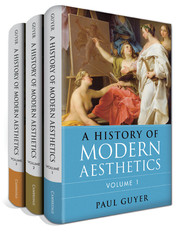Book contents
- Volume 1 The Eighteenth Century
- Volume 2 The Nineteenth Century
- Volume 3 The Twentieth Century
- Frontmatter
- Contents
- Acknowledgments
- Introduction
- Part One German Aesthetics in the Twentieth Century
- 1 German Aesthetics between the Wars
- 2 German Aesthetics after World War II
- Part Two Aesthetics in Britain until World War II
- Part Three American Aesthetics in the First Half of the Twentieth Century
- Part Four Wittgenstein and After
- Bibliography
- References
1 - German Aesthetics between the Wars
Lukács and Heidegger
from Part One - German Aesthetics in the Twentieth Century
Published online by Cambridge University Press: 05 June 2015
- Volume 1 The Eighteenth Century
- Volume 2 The Nineteenth Century
- Volume 3 The Twentieth Century
- Frontmatter
- Contents
- Acknowledgments
- Introduction
- Part One German Aesthetics in the Twentieth Century
- 1 German Aesthetics between the Wars
- 2 German Aesthetics after World War II
- Part Two Aesthetics in Britain until World War II
- Part Three American Aesthetics in the First Half of the Twentieth Century
- Part Four Wittgenstein and After
- Bibliography
- References
Summary
It might seem strange to take György Lukács (1885–1971) and Martin Heidegger (1889–1976) as the main examples of German aesthetics between the two world wars. Not only were there other important philosophers who wrote on aesthetics (such as Ernst Cassirer, whom however we will consider as part of the history of twentieth-century aesthetics in the United States, where at least until recently his influence was much greater than in Germany); not only was Lukács not German at all, but Hungarian (although, like many other urban Hungarian Jews, he was of German descent, and throughout his life wrote his main works in German); above all, they were at opposite ends of the political spectrum, Lukács known as a Marxist for most of his life and even flourishing in the Stalinist Soviet Union while Heidegger was permanently tainted by his affiliation with the Nazis in the 1930s even if he withdrew from any official position other than his professorship after his year as the Nazi-appointed rector of his university in 1933–4 (he retained his membership in the party until the end of the war). But in spite of all their differences, Lukács and Heidegger shared one trait that binds them together and makes them representative of German aesthetics in their time: a focus on art and aesthetic experience as a vehicle of important truth, truth about human society in the case of Lukács and about human being itself, as something even more fundamental than society, in the case of Heidegger. For that reason they will be considered together in this chapter. Ernst Cassirer, who might also be considered a major contributor to aesthetics during the interwar period, had his major influence in the United States after World War II and for that reason will be considered in our discussion of American rather than German aesthetics.
- Type
- Chapter
- Information
- A History of Modern Aesthetics , pp. 9 - 42Publisher: Cambridge University PressPrint publication year: 2014



